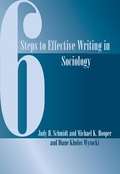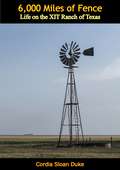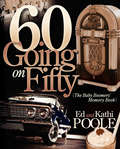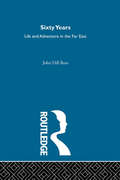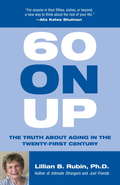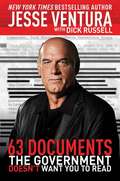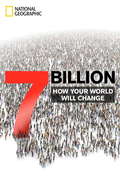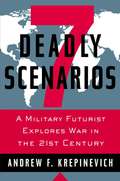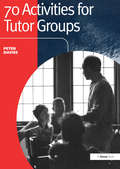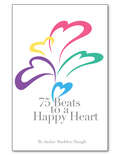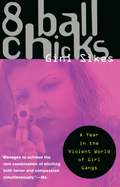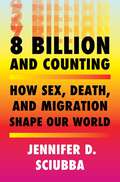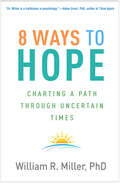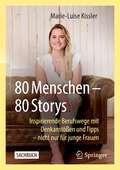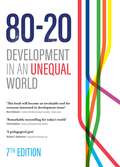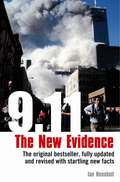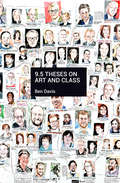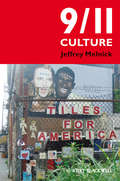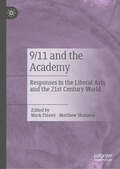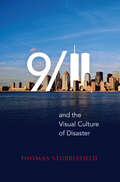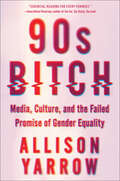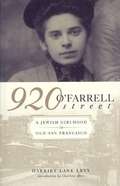- Table View
- List View
6 Steps to Effective Writing in Sociology
by Judy H. Schmidt Michael K. Hooper Diane Kholos WysockiTools of the trade for being an effective academic writer.
6,000 Miles of Fence: Life on the XIT Ranch of Texas
by Cordia Sloan DukeThe fabulous XIT Ranch has been celebrated in song, story, and serious history. This book of reminiscences of old XIT cowmen puts on record the everyday life of the individuals who made the ranch run.During her years as a ranch wife, Cordia Sloan Duke wrote a diary; excerpts from her written recordings are here brought together with the reminiscences of the ranch hands. Their forthright, yet picturesque, discussion of ranching hardships and dangers dissipates Hollywood and TV glamorizing, and instead they relate in honest cowboy language what actually happened inside the XIT’s 6,000 miles of fence.“Joe Frantz, one of Texas’ most able writers, has taken the diary of Mrs. Cordia Sloan Duke, widow of XIT’s division manager, plus the terse and pithy reminiscences she collected from former XIT cowboys, and turned them into a unique, readable and realistic account of the cowboy’s way of life.”—New York Times Book Review“This book, with all the merit of being an organized and beautifully presented story, is more than a social history; it is source material, resting on the firm bedrock of first-hand accounts. Hence, while it joins in many libraries and collections several shelves of other cowboy books, it will always be on the top shelf with a select few that have made real contributions to the history of the American West. As a man should be measured by his own standards, and an event in terms of its own time, a book should be evaluated in relation to its purpose. By this standard, as well as by comparison with other books in its library classification, 6,000 Miles of Fence is a success.”—Southwestern Historical Quarterly
60 Going on Fifty: The Baby Boomers' Memory Book
by Ed Poole Kathi PooleOld friends from the class of 1960 at an Indiana high school share nostalgic memories as their fiftieth reunion draws near . . . This is the story of sixteen classmates who graduated from Indiana&’s Columbus High School in May, 1960. With their fiftieth high school reunion on the horizon, the &“Columbus Crew&” reconnected, and here the guys tell stories about growing up in the &’40s, &’50s, and &’60s, and how those times impacted who they are today—offering both a glimpse into history and a delightful ride down Memory Lane. While the stories are unique to the Columbus Crew, they will rekindle memories for anyone who grew up in this glorious era—and for children and grandchildren of baby boomers, they show what life was like in mid-twentieth-century America. Let the Columbus Crew take you back to the days of flat tops, LPs, the Hula Hoop, transistor radios, Lassie, 20 cents per gallon gas, big bands, rock and roll—while sharing personal reminiscences of first cars, girlfriends, sports, jobs, getting into trouble and finding their way out, and much more.
60 Years Life/Adventure (2v Set): Sixty Yrs Life Adv Far Et
by John Dill RossFirst Published in 1968. Life and Adventures in the Far East is a record of Captain Northwood's adventures into Borneo, Saigon, Singapore, Aden, that of his businesses.
60 on Up
by Lillian B. RubinThe Golden Years? You've got to be kidding. Part serious, part comic, these words reflect our ambivalence about aging in the twenty-first century. Is it a blessing or a curse? With refreshing candor and characteristic wit, best-selling author Lillian Rubin looks deeply into the issues of our graying nation, into the triumph of our new longevity, and the pain, both emotional and physical, that lies right alongside it. Through thought-provoking interviews, research, and unflinching analysis of her own life experience, Dr. Rubin offers us a much needed roadmap for the uncharted territory that lies ahead. In a country where seventy-eight million Baby Boomers are moving into their sixties and economists worry that they're "the monster at the door" who will break the Social Security bank and trash the economy, where forty percent of sixty-five-year-olds are in the "sandwich generation" taking care of their parents while often still supporting their children, and where Americans eighty-five and older represent the fastest growing segment of the population, we cannot afford to pretend that our expanded old age is just a walk on the sunny side of the street, that "sixty is the new forty," "eighty the new sixty," and that we'll all live happily ever after. In this wide-ranging book, Dr. Rubin examines how the new longevity ricochets around our social and emotional lives, affecting us all for good and ill from adolescence into senescence. How, she asks, do sixty-somethings fill another twenty, thirty, or more years, post retirement, without a "useful" identity or obvious purpose? What happens to sex as we move through the decades after sixty? What happens to long-cherished friendships aslife takes unexpected turns? What happens when at seventy, instead of living the life of freedom we dreamed about, we find ourselves having to take care of Mom and Dad? What happens to the inheritances boomers have come to expect when their parents routinely live into their eighties and beyond and the cost for their care soars? In tackling the subject of aging over a broad swath of the population, cutting across race, class, gender, and ability, Lillian Rubin gives us a powerful and long-overdue reminder that all of us will be touched by the problems arising from our new longevity. The best hope is to understand the realities we face thoroughly and to prepare--as individuals and as a society--for a long life from sixty on up. "In eleven books spanning more than three decades, Lillian Rubin has eloquently described the hopes, fears, and sometimes the anguish that people feel as they negotiate their way through major social changes, such as the revolution in gender roles and sexuality and the destabilization of work-life by globalization. Now she tackles the personal and social consequences of our extended life spans. Perceptive, compassionate, and painfully honest, this book will enthrall readers of any age. " --Stephanie Coontz, author of The Way We Never Were: American Families and the Nostalgia Trap "The thing about Lillian Rubin--and this book is no exception--is that you can depend on her, as a writer and thinker, to tell the truth. If you want the real, insightful, unvarnished, necessary, truth on aging, it's right here in 60 On Up. And, as always, it's a treasure. " --Peggy Orenstein, author of Waiting for Daisy "Once upon a time we had rites of passage to easeour way from adulthood into old age. Now we have Lillian Rubin. 60 on Up is everything most books on aging are not. It is not sentimental, not filled with stale advice to keep busy, avoid calories, and think young. Instead, it offers authentic wisdom about the complexities of aging. Its fiercely realistic but tender explorations are strangely comforting because they relieve us of the burden of denial and give us a vision of facing our later years with dignity and courage. It is a wonderful book, filled with the poignant beauty of all transient life. " --Sam Keen,
63 Documents the Government Doesn't Want You to Read
by Jesse Ventura Dick RussellThe official spin on numerous government programs is flat-out bullshit, according to Jesse Ventura. In this incredible collection of actual government documents, Ventura, the ultimate non-partisan truth-seeker, proves it beyond any doubt. He and Dick Russell walk readers through 63 of the most incriminating programs to reveal what really happens behind the closed doors. In addition to providing original government data, Ventura discusses what it really means and how regular Americans can stop criminal behavior at the top levels of government and in the media. Among the cases discussed: *The CIA's top-secret program to control human behavior; *Operation Northwoods--the military plan to hijack airplanes and blame it on Cuban terrorists; *The discovery of a secret Afghan archive--information that never left the boardroom; *Potentially deadly healthcare cover-ups, including a dengue fever outbreak; *What the Department of Defense knows about our food supply--but is keeping mum. Although these documents are now in the public domain, the powers that be would just as soon they stay under wraps. Ventura's research and commentary sheds new light on what they're not telling you and why it matters.
6th Grade Social Studies: Latin America, Caribbean, Canada, Europe, Australia (Georgia)
by Carole MarshYou are going to learn all about the geography, history, people, economics, government, and citizenship (and a few other fun things!) of important world regions. As you progress through the sixth grade, you will discover that learning about other countries helps you understand (and appreciate!) your own country.
7 Billion: How Your World Will Change
by National GeographicIn late October 2011, the 7 billionth citizen of planet Earth was born. To mark the event, National Geographic magazine commissioned seven articles that explore the fascinating issues - including demographics, food security, climate change, fertility trends, managing biodiversity - surrounding this topic, which are collected for the first time in this special ebook. Environment editor Robert Kunzig starts by sketching out a natural history of population. The issues associated with population growth seem endless: poverty, food and water supply, world health, climate change, deforestation, fertility rates, and more. In additional chapters Elizabeth Kolbert explores a new era - the "Anthropocene," or the age of man - defined by our massive impact on the planet, which will endure long after our cities have crumbled; and takes us to the Mediterranean, where she delves into issues associated with increasing ocean acidification. In Bangladesh, Don Belt explores how the people of this crowded region can teach us about adapting to rising sea levels. In "Food Ark" we travel deep within the earth and around the globe to explore the seed banks that are preserving the variety of food species we may need to increase food production on an increasingly crowded planet. In Brazil, Cynthia Gournay explores the phenomenon of "Machisma" and shows how a mix of female empowerment and steamy soap operas helped bring down Brazil's fertility rate and stoke its vibrant economy. Additionally we explore threats to biodiversity, and the return of cities - which may be the solution to many of our population woes. Join National Geographic on this incredible journey to explore our rapidly growing planet.
7 Deadly Scenarios: A Military Futurist Explores War in the 21st Century
by Andrew F. KrepinevichThroughout history, great powers have fallen because they failed to anticipate new threats to their security. Now strategy expert Krepinevich forecasts the most horrifying and yet very possible dangers facing America.
70 Activities for Tutor Groups
by Peter DaviesThe pressure on contact time with students and the results required from it are constantly increasing - which means that tutors have to be more and more creative in how they approach their work. This book provides some solutions. 70 Activities for Tutor Groups explores the many and varied ways in which tutors can provoke and encourage meaningful, constructive and focused discussion among their students. It takes the form of a classified and cross-referenced manual of groupwork activities. For ease of use each activity is presented in a common format: ¢ In a nutshell ¢ Aims ¢ What is needed ¢ Time needed ¢ How it works ¢ Good example in action ¢ Diagram ¢ Advantages of this activity ¢ Potential problem(s) ¢ Main learning outcome ¢ Variation. The practical, 'low-tech' approach taken by Peter Davies means that these activities (which have all been trialled and are known to work) can be used easily by all tutors, at any level, and in any subject. If you are committed to improving the effectiveness of your work with groups you need look no further!
75 Beats to a Happy Heart
by Jackie Madden HaughAs a little girl, Jackie Madden Haugh was taught by her parents that there were two types of heartbeats: one that served as the life force within the physical frame, sending blood and oxygen to all parts of the body, and another that resided in the spirit, a mystical pulse that nourished the soul. But, it wasn’t until Jackie became a caregiver to both her parents in their declining years, and suffered through a divorce, hat she discovered the true way to feed the soul was by living a life in constant gratitude. Being thankful for all the wonders in life is easy, that takes no effort. But, when we’re appreciative for the challenges and heartbreaks thrown our way, for those are our lessons, we’re lead down the winding road to our great becoming; who we were born to be. 75 Beats to a Happy Heart are universal inspirational, funny, and tender short stories from Jackie’s column in the Los Altos Town Crier. By looking for joy in the minutia of her days; those special moments that make a heart pause and reflect, Jackie found the rhythmic, spiritual tapping, that beating pulse that nurtured and fed her soul.
8 Ball Chicks: A Year In The Violent World Of Girl Gangs
by Gini SikesDismissed by the police as mere adjuncts to or gofers for male gangs, girl gang members are in fact often as emotionally closed off and dangerous as their male counterparts. Carrying razor blades in their mouths and guns in their jackets for defense, they initiate drive-by shootings, carry out car jackings, stomp outsiders who stumble onto or dare to enter the neighborhood, viciously retaliate against other gangs and ferociously guard their home turf.But Sikes also captures the differences that distinguish girl gangs-abortion, teen pregnancy and teen motherhood, endless beatings and the humiliation of being forced to have sex with a lineup of male gangbangers during initiation, haphazardly raising kids in a household of drugs and guns with a part-time boyfriend off gangbanging himself. Veteran journalist Gini Sikes spends a year in the ghettos following the lives of several key gang members in South Central Los Angeles, San Antonio, and Milwaukee. In 8 Ball Chicks, we discover the fear and desperate desire for respect and status that drive girls into gangs in the first place--and the dreams and ambitions that occasionally help them to escape the catch-22 of their existence.From the Trade Paperback edition.
8 Billion and Counting: How Sex, Death, and Migration Shape Our World
by Jennifer D. SciubbaA provocative description of the power of population change to create the conditions for societal transformation. As the world nears 8 billion people, the countries that have led the global order since World War II are becoming the most aged societies in human history. At the same time, the world’s poorest and least powerful countries are suffocating under an imbalance of population and resources. In 8 Billion and Counting, political demographer Jennifer D. Sciubba argues that the story of the twenty-first century is less a story about exponential population growth, as the previous century was, than it is a story about differential growth—marked by a stark divide between the world’s richest and poorest countries. Drawing from decades of research, policy experience, and teaching, Sciubba employs stories and statistics to explain how demographic trends, like age structure and ethnic composition, are crucial signposts for future violence and peace, repression and democracy, poverty and prosperity. Although we have a diverse global population, demographic trends often follow predictable patterns that can help professionals across the corporate, nonprofit, government, and military sectors understand the global strategic environment. Through the lenses of national security, global health, and economics, Sciubba demonstrates the pitfalls of taking population numbers at face value and extrapolating from there. Instead, she argues, we must look at the forces in a society that amplify demographic trends and the forces that dilute them, particularly political institutions, or the rules of the game. She shows that the most important skills in demographic analysis are naming and being aware of your preferences, rethinking assumptions, and asking the right questions. Provocative and engrossing, 8 Billion and Counting is required reading for business leaders, policy makers, and anyone eager to anticipate political, economic, and social risks and opportunities. A deeper understanding of fertility, mortality, and migration promises to point toward the investments we need to make today to shape the future we want tomorrow.
8 Ways to Hope: Charting a Path through Uncertain Times
by William R. MillerYou can't take a leap of faith without it. It lets you dream of a brighter future. And in a world worn down by political conflict, climate change, war, and other perils, many worry about losing it. Pioneering psychologist William R. Miller takes a fresh look at hope and its transformative potential in this concise, compassionate book. Explore eight different facets of hope that enable people to clarify their goals, envision new possibilities, find purpose, enhance motivation, and persevere against tough odds. Dr. Miller guides you to reflect on your own relationship to hope and how you can cultivate it. Vivid personal stories, historical examples, and cutting-edge scientific findings reveal how choosing hope over fear can be a powerful force for change.
8-Bit Apocalypse: The True Story Behind The Classic Video Game
by Alex Rubens Jeff GerstmannThe first history of Atari’s Missile Command, and its unforeseen effects on its creators and the culture Before Call of Duty, before World of Warcraft, before even Super Mario Bros., the video game industry exploded in the late 1970s with the advent of the video arcade. Leading the charge was Atari Inc., the creator of, among others, the iconic game Missile Command. The first game to double as a commentary on culture, Missile Command put the players’ fingers on “the button,” making them responsible for the fate of civilization in a no-win scenario, all for the price of a quarter. The game was a marvel of modern culture, helping usher in both the age of the video game and the video game lifestyle. Its groundbreaking implications inspired a fanatical culture that persists to this day. As fascinating as the cultural reaction to Missile Command were the programmers behind it. Before the era of massive development teams and worship of figures like Steve Jobs, Atari was manufacturing arcade machines designed, written, and coded by individual designers. As earnings from their games entered the millions, these creators were celebrated as geniuses in their time; once dismissed as nerds and fanatics, they were now being interviewed for major publications, and partied like Wall Street traders. However, the toll on these programmers was high: developers worked 120-hour weeks, often opting to stay in the office for days on end while under a deadline. Missile Command creator David Theurer threw himself particularly fervently into his work, prompting not only declining health and a suffering relationship with his family, but frequent nightmares about nuclear annihilation. To truly tell the story from the inside, tech insider and writer Alex Rubens has interviewed numerous major figures from this time: Nolan Bushnell, founder of Atari; David Theurer, the creator of Missile Command; and Phil Klemmer, writer for the NBC series Chuck, who wrote an entire episode for the show about Missile Command and its mythical “kill screen.” Taking readers back to the days of TaB cola, dot matrix printers, and digging through the couch for just one more quarter, Alex Rubens combines his knowledge of the tech industry and experience as a gaming journalist to conjure the wild silicon frontier of the 8-bit ’80s. 8-Bit Apocalypse: The Untold Story of Atari's Missile Command offers the first in-depth, personal history of an era for which fans have a lot of nostalgia.
80 Menschen – 80 Storys: Inspirierende Berufswege mit Denkanstößen und Tipps – nicht nur für junge Frauen
by Marie-Luise KisslerOb Bundestagsabgeordnete, Tattoo-Künstlerin, Chocolatier oder Schornsteinfegerin – das Leben ist ein Kaleidoskop von Möglichkeiten. Dieses Buch zeigt 80 Persönlichkeiten und inspiriert junge Menschen ihren eigenen, einzigartigen Berufsweg zu verwirklichen.Die Interviews enthalten exklusive Ratschläge von 80 erfolgreichen Role Models - sie erzählen aus ihrem Leben, nennen berufliche Erfolge und Fehler beim Namen und verraten persönliche Tipps und Tricks, wie junge Frauen zwischen Selbst- und Fremdanspruch ihre eigene Berufung finden. Die 80 Interviewpartnerinnen sind: Trixie Bannert – Claudia Bechstein – Sandra Berndt – Marco Boos – Sylvia Borcherding – Katja Borghaus – Julia Börs – Julia Bösch – Andrea Bruckner – Ilka Brühl – Linda Burchhardt – Frank Buschmann – Valentina Daiber – Angela De Giacomo - Vanessa Didam – Sabine U. Dietrich – Özlem Doger-Herter – Anja Dorny – Julia Dorny – Katharina Fankidejski – Emilia Fehse – Bettina Fetzer – Nicolette Fountaris – Marie-Christin Ghanbari – Kirsten Heike Giering – Saskia Stella Gleitsmann – Laura Große – Laura Halfas – Ilka Hartmann – Caitlin Hennen – Josephine Henning – Verena Herb – Ulrike Hiller – Nicole Hölscher – Elke Holst – Bettina Hueske – Petra Justenhoven – Lise-Christine Kobla Mendama – Hatice Koca – Carmen Köhler – Anne Kozlowski – Dirk Kreuter – Toma Kubiliute – Kevin Kugel – Ricarda Lang – Meriem Lebdiri – Monika Maria Lehmann – Elisabeth Lepique – Susanne Liebermann – Chenchao Liu – Dubravka Maljevic – Thomas Mickeleit – Lan Anh Nguyen – Martina Niemann – Laura Nolte – Bettina Pauck – Susanne Pfab – Astrid Quentell – Angelique Renkhoff-Mücke – Johanna Röh – Colette Rückert-Hennen – Nicole Schilling – Sabine Schmittroth – Laura Schönberger – Gabriele Sons – Britta Steffen – Julian F. M. Stoeckel – Sarah Süß – Martyna Trajdos – Marie-Christine Trappen – Anastasia Umrik – Lisa Unruh – Katja von Doren – Linda van Rennings – Christina Virzí – Marion A. Weissenberger-Eibl – Hiltrud Dorothea Werner – Alina Wichmann – Nicola Winter – Laura Zieger.
80: Development in an Unequal World
by Ciara Regan Colm Regan Tony DalyA development education resource designed and written by an international group of authors and educationalists. It explores inequalities and injustices in an accessible and understandable fashion, with infographics, figures, graphs, photographs and cartoons. Now in its seventh edition, it is extensively used in universities, schools, adult and youth groups and NGOs.Tony Daly is co-ordinator of Irish development education and human rights organisation 80:20 Educating and Acting for a Better World and project manager for an NGO consortium website www.developmenteducation.ie. Previously, he led a pilot project advancing a human rights approach to community development with the British Institute for Human Rights, London and has been directly engaged in human rights education, development education, curriculum reform and research projects in Ireland, Northern Ireland, the United Kingdom and Australia for over 15 years. He holds degrees from University College Dublin and University College London.Ciara Regan is education consultant to 80:20 Educating and Acting for a Better World. Since 2010 she has worked directly on the developmenteducation.ie website and has researched and published in the area of women and development in the context of HIV and AIDS in Zambia. She has worked on community art projects in Lusaka, Zambia and across Dublin on a wide range of issues such as public accountability, women’s rights, diversity and interculturalism. She holds degrees from NUI Galway and Birkbeck, University of London.Colm Regan initiated and, for many years edited 80:20 Development in an Unequal World – the reader is now widely used internationally, particularly in Africa. He is former co-ordinator of 80:20 in Ireland and has been professionally active for over 40 years in education for human rights, justice and human development – subjects he has written extensively on. In this context, he has worked in development education in Ireland, the UK, Australia, Ethiopia, Rwanda, Brazil and Zambia. He holds post graduate degrees from Simon Fraser University, Vancouver and McGill University, Montreal and now lives, writes and teaches in Gozo, Malta.
9.11: Fully Updated and Revised
by Ian HenshallThe original 9/11 Revealed attracted lavish praise from reviewers in the Daily Mail and Sunday Times for the 'huge gaps' it exposed in the official 9/11 story. It became a non-fiction bestseller despite a wall of silence by the broadcast media and condemnation in a special web page set up by the US State Department. Since then the story has produced many sinister new twists, including: Pentagon whistleblowers have accused the 'Independent 9/11 Commission' of lying; long-suppressed eyewitness testimony has been released confirming multiple explosions in the Twin Towers before and during their collapses; the much vaunted video purporting to prove that Flight 77 hit the Pentagon showed nothing at all; and an analysis of terrorist trials and arrests since 2001 indicates that far from the '600 Al Qaeda sleeper cells in the US' (CIA) there were none at all. In this sequel to 9/11 Revealed, Ian Henshall examines the precedents of black operations by the US/UK, from Northern Ireland to Italy, from Vietnam to Kosovo; he looks at the various 9/11 theories, including the latest twists in the official story, and tests them against the evidence. Finally, he asks what might happen when the storm of popular outrage collides with the regime in Washington and London and outlines the radical changes needed if Washington and London are ever again to function as genuine democracies.
9.11: Fully Updated and Revised
by Ian HenshallThe original 9/11 Revealed attracted lavish praise from reviewers in the Daily Mail and Sunday Times for the 'huge gaps' it exposed in the official 9/11 story. It became a non-fiction bestseller despite a wall of silence by the broadcast media and condemnation in a special web page set up by the US State Department. Since then the story has produced many sinister new twists, including: Pentagon whistleblowers have accused the 'Independent 9/11 Commission' of lying; long-suppressed eyewitness testimony has been released confirming multiple explosions in the Twin Towers before and during their collapses; the much vaunted video purporting to prove that Flight 77 hit the Pentagon showed nothing at all; and an analysis of terrorist trials and arrests since 2001 indicates that far from the '600 Al Qaeda sleeper cells in the US' (CIA) there were none at all. In this sequel to 9/11 Revealed, Ian Henshall examines the precedents of black operations by the US/UK, from Northern Ireland to Italy, from Vietnam to Kosovo; he looks at the various 9/11 theories, including the latest twists in the official story, and tests them against the evidence. Finally, he asks what might happen when the storm of popular outrage collides with the regime in Washington and London and outlines the radical changes needed if Washington and London are ever again to function as genuine democracies.
9.5 Theses on Art and Class
by Ben Davis9.5 Theses on Art and Class seeks to show how a clear understanding of class makes sense of what is at stake in a broad number of contemporary art's most persistent debates, from definitions of political art to the troubled status of "outsider" and street art to the question of how we maintain faith in art itself.Ben Davis currently lives and works in New York City where he is Executive Editor at Artinfo.
9/11 Culture
by Jeffrey Melnick9/11 Culture serves as a timely and accessible introduction to the complexities of American culture in the wake of the 9/11 attacks. Gives balanced examinations of a broad catalogue of artifacts from film, music, photography, literary fiction, and other popular arts Investigates the ways that 9/11 has exerted a shaping force on a wide range of practices, from the politics of femininity to the poetics of redemption Includes pedagogical material to assist understanding and teaching, including film and discographies, and a useful teachers' preface
9/11 and the Academy: Responses in the Liberal Arts and the 21st Century World
by Mark Finney Matthew ShannonThis book explores the impact of September 11, 2001 upon interdisciplinary scholarship and pedagogy in the liberal arts. Since “the day that changed everything”, many forces have transformed institutions of higher education in the United States and around the world. The editors and contributors consider the extent to which the influence of 9/11 was direct, or part of wider structural changes within academia, and the chapters represent a wide range of interdisciplinary perspectives on how the production and dissemination of knowledge has changed since 2001. Some authors demonstrate that new forms of inquiry, exploration, and evidence have been created, much of it focused on the causes, consequences, and meanings of the terror attacks. Others find that scholars sought to understand 9/11 by applying old theoretical and empirical insights and reviving lines of questioning that have become relevant. The contributors also examine the impact of 9/11 on higher education administration and liberal arts pedagogies. Among the many collective findings is that scholars in the humanities and critical social sciences have been most attentive to the place of 9/11 in society and academic culture. This eclectic collection will appeal to students and scholars interested in the place of the liberal arts in the twenty-first century world.
9/11 and the Visual Culture of Disaster
by Thomas StubblefieldThe day the towers fell, indelible images of plummeting rubble, fire, and falling bodies were imprinted in the memories of people around the world. Images that were caught in the media loop after the disaster and coverage of the attack, its aftermath, and the wars that followed reflected a pervasive tendency to treat these tragic events as spectacle. Though the collapse of the World Trade Center was "the most photographed disaster in history," it failed to yield a single noteworthy image of carnage. Thomas Stubblefield argues that the absence within these spectacular images is the paradox of 9/11 visual culture, which foregrounds the visual experience as it obscures the event in absence, erasure, and invisibility. From the spectral presence of the Tribute in Light to Art Spiegelman's nearly blank New Yorker cover, and from the elimination of the Twin Towers from television shows and films to the monumental cavities of Michael Arad's 9/11 memorial, the void became the visual shorthand for the incident. By examining configurations of invisibility and erasure across the media of photography, film, monuments, graphic novels, and digital representation, Stubblefield interprets the post-9/11 presence of absence as the reaffirmation of national identity that implicitly laid the groundwork for the impending invasions of Iraq and Afghanistan.
90s Bitch: Media, Culture, and the Failed Promise of Gender Equality
by Allison Yarrow“Allison Yarrow takes you back to the era of Anita Hill and Monica Lewinsky and Tonya Harding and examines how the media fueled America’s sexism.”—BustleTo understand how we got here, we have to rewind the VHS tape. 90s Bitch tells the real story of women and girls in the 1990s, exploring how they were maligned by the media, vilified by popular culture, and objectified in the marketplace. Trailblazing women like Hillary Clinton, Anita Hill, Madeleine Albright, Janet Reno, and Marcia Clark were undermined. Newsmakers like Britney Spears, Monica Lewinsky, Tonya Harding and Lorena Bobbitt were shamed and misunderstood. The advent of the twenty-four-hour news cycle reinforced society's deeply entrenched misogyny. Meanwhile, marketers hijacked feminism, sold “Girl Power,” and poisoned a generation. Today echoes of 90s “bitchification” still exist everywhere. To understand why, we must revisit and interrogate the 1990s—a decade in which empowerment was twisted into objectification, exploitation, and subjugation. Award–winning journalist Allison Yarrow’s timely examination is a must-read for anyone trying to understand twenty-first century sexism and end it for the next generation.“Yarrow’s biting autopsy of the decade scrutinizes the way society reduced—or “bitchified”—women . . . Direct quotes from politicians, journalists and comedians about the women provide the most jarring, oh-my-god-that-really-happened portions of Yarrow’s decade excavation.” —Pittsburg Post-Gazette“Allison Yarrow is a feminist and a muckraker in the tradition of Betty Friedan, Naomi Klein, and bell hooks.” —Steve Almond, author of Bad Stories: What the Hell Just Happened to Our Country“Yarrow is a skillful scene setter.” —The Los Angeles Review of Books“‘Essential reading for every feminist.” Anne Helen Petersen, author of Too Fat, Too Slutty, Too Loud
920 O'Farrell Street: A Jewish Girlhood in Old San Francisco
by Harriet L. Levy Charlene AkersThe girlhood memoir of Harriet Lane Levy, friend and neighbor of Alice B. Toklas, provides an intimate and detailed glimpse into San Francisco's Victorian past.
